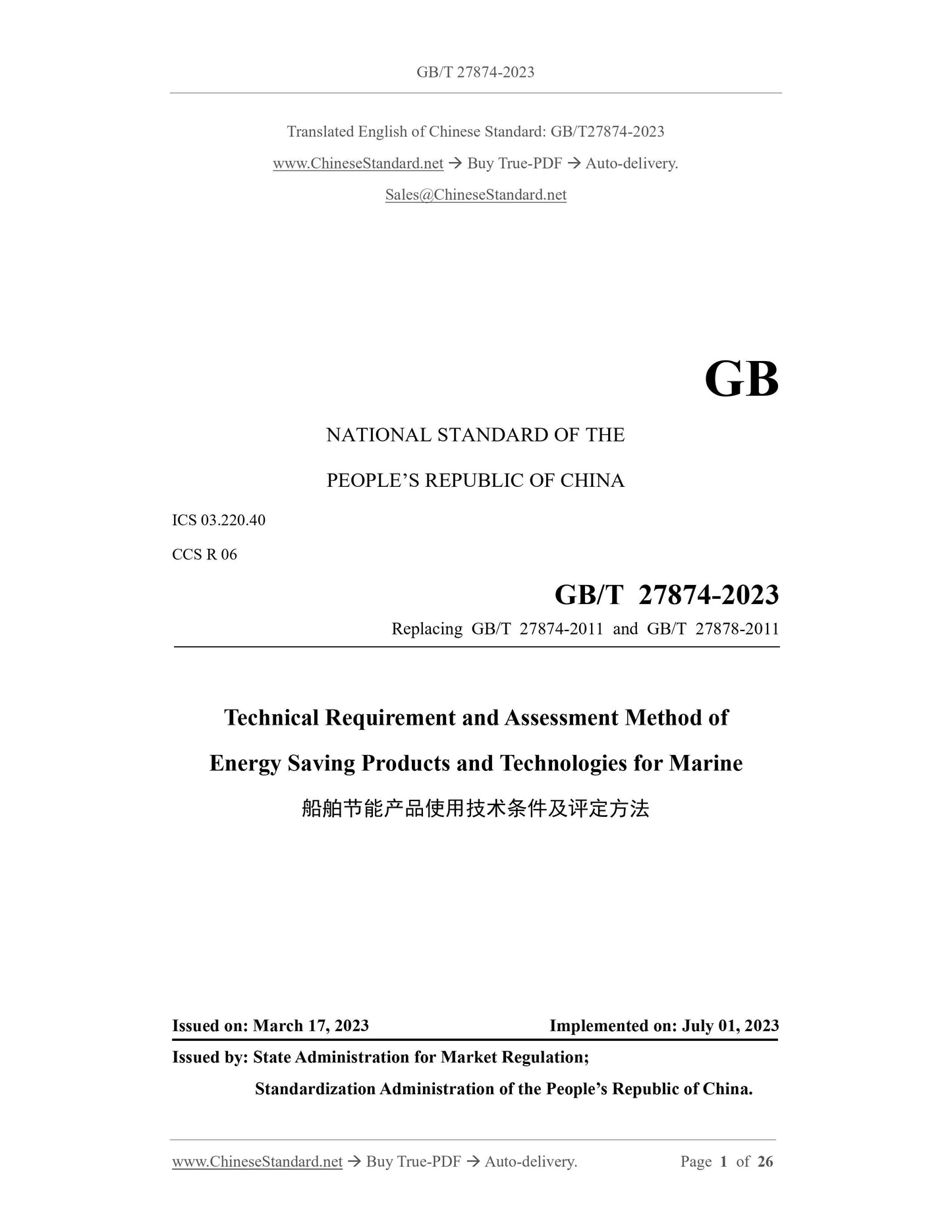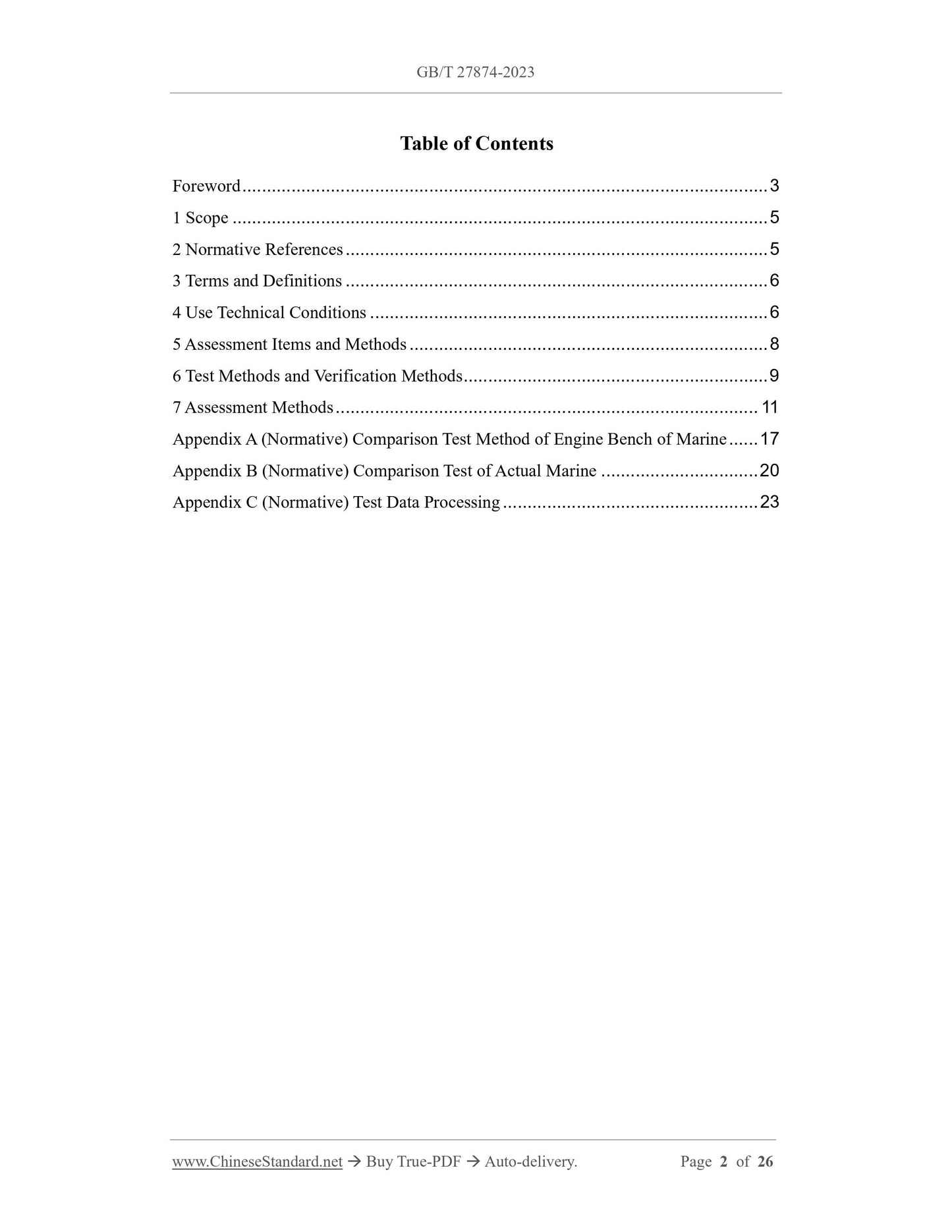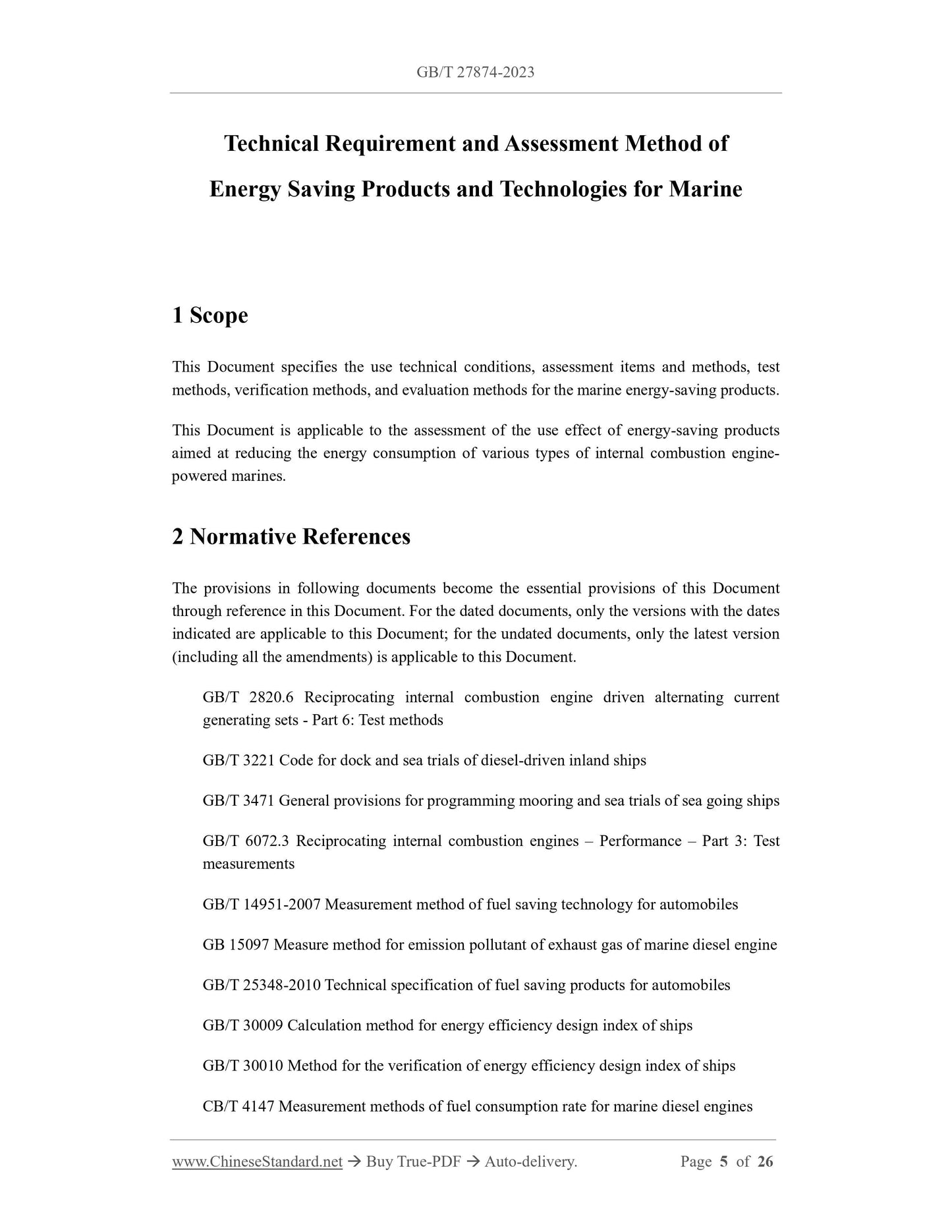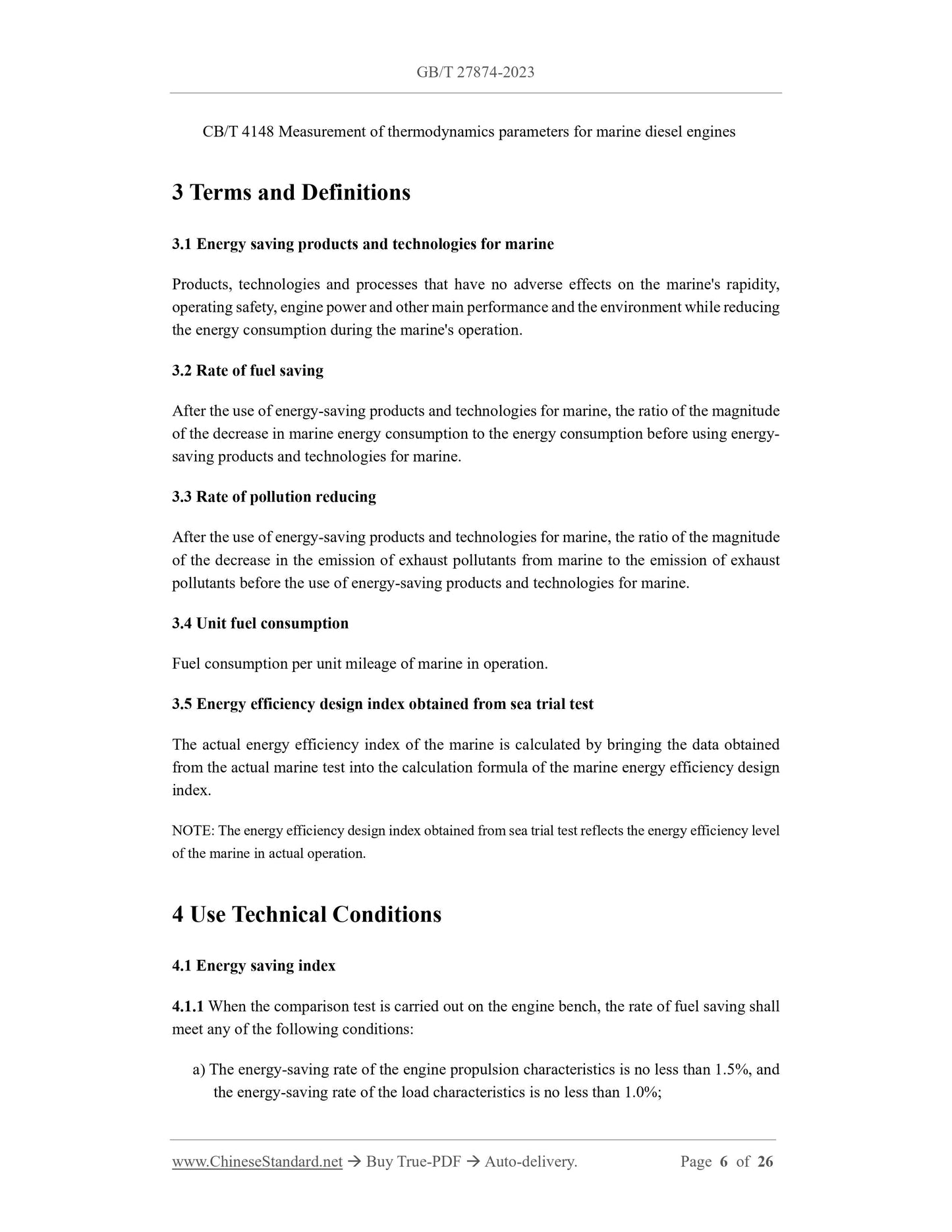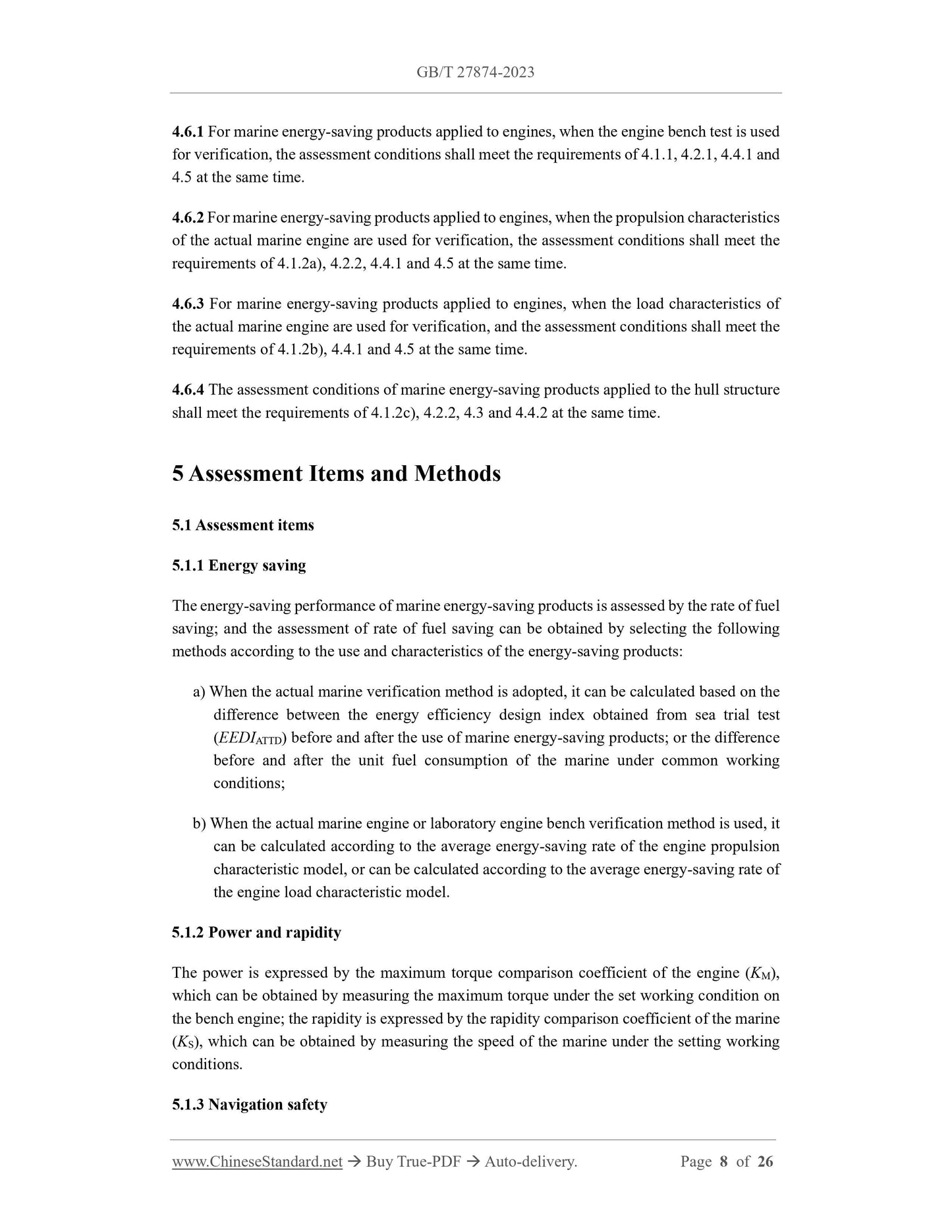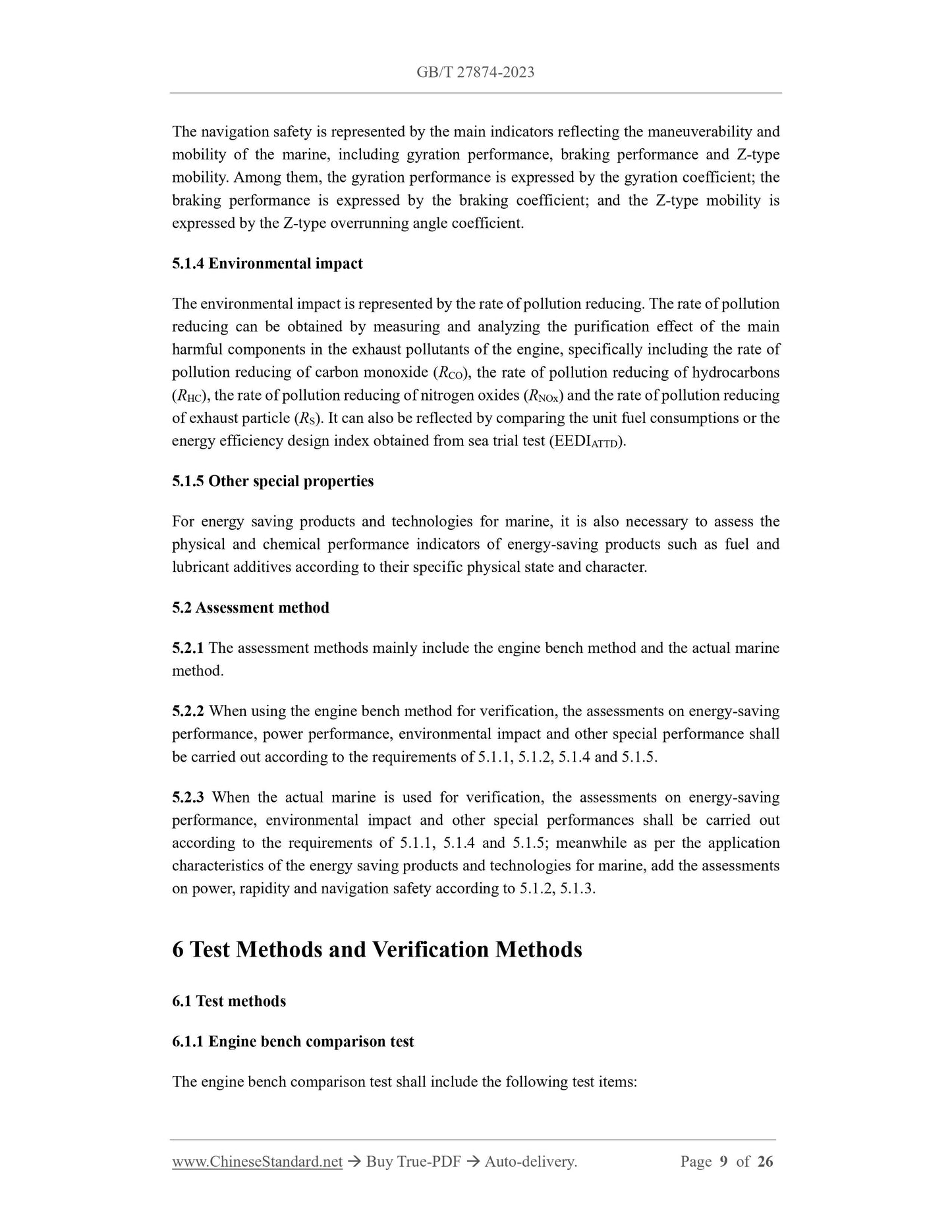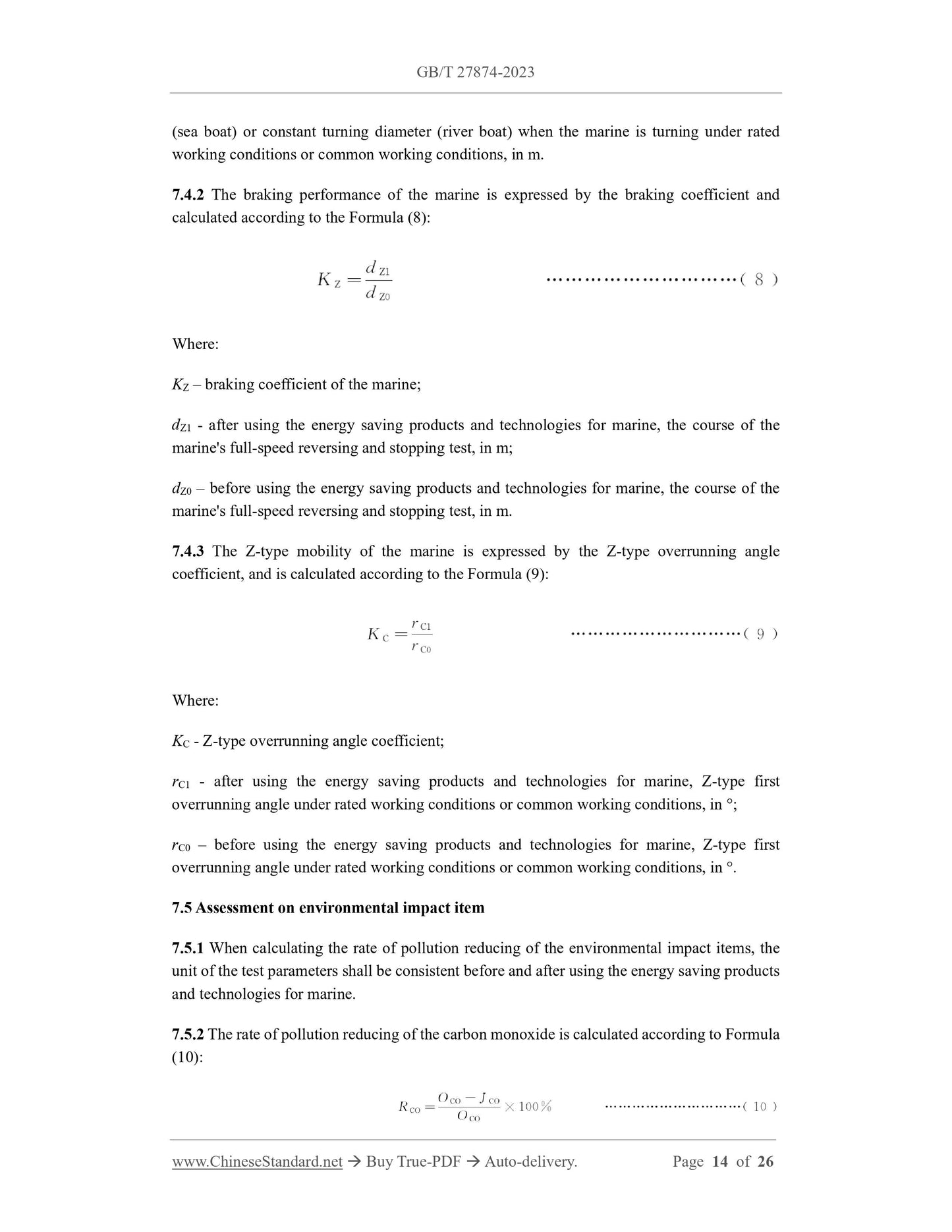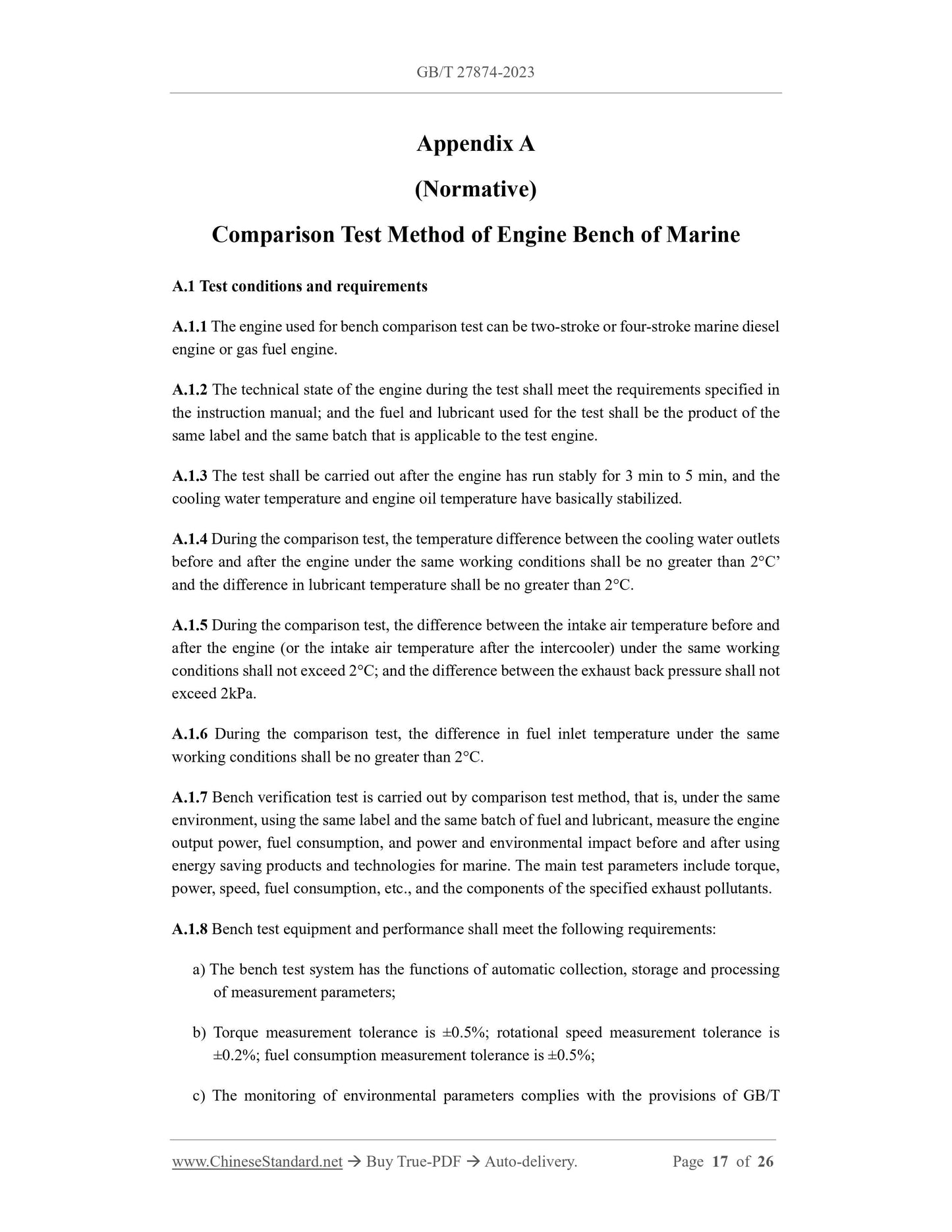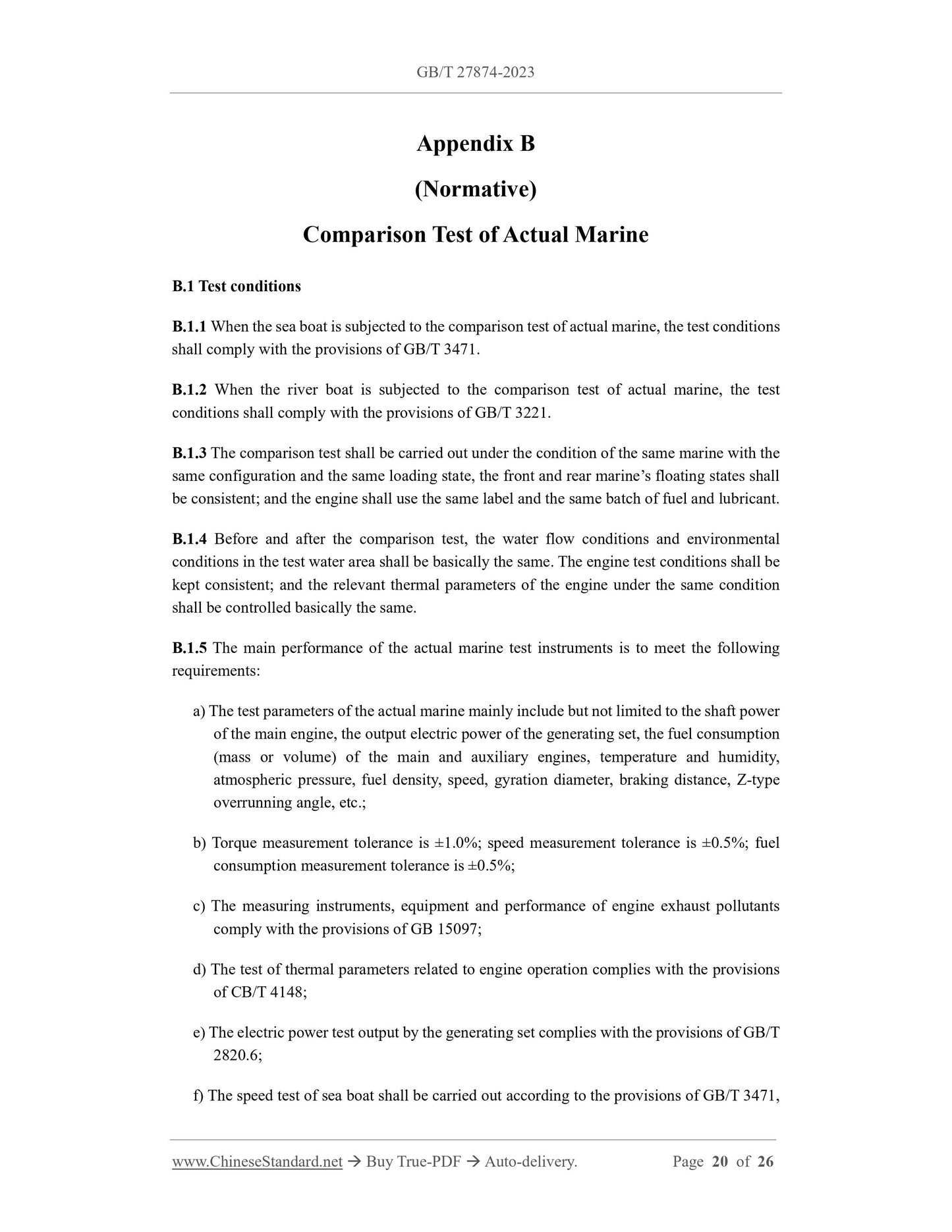1
/
of
10
www.ChineseStandard.us -- Field Test Asia Pte. Ltd.
GB/T 27874-2023 English PDF (GB/T27874-2023)
GB/T 27874-2023 English PDF (GB/T27874-2023)
Regular price
$290.00
Regular price
Sale price
$290.00
Unit price
/
per
Shipping calculated at checkout.
Couldn't load pickup availability
GB/T 27874-2023: Technical requirement and assessment method of energy saving products and technologies for marine
Delivery: 9 seconds. Download (& Email) true-PDF + Invoice.
Get Quotation: Click GB/T 27874-2023 (Self-service in 1-minute)
Historical versions (Master-website): GB/T 27874-2023
Preview True-PDF (Reload/Scroll-down if blank)
GB/T 27874-2023
GB
NATIONAL STANDARD OF THE
PEOPLE’S REPUBLIC OF CHINA
ICS 03.220.40
CCS R 06
Replacing GB/T 27874-2011 and GB/T 27878-2011
Technical Requirement and Assessment Method of
Energy Saving Products and Technologies for Marine
ISSUED ON: MARCH 17, 2023
IMPLEMENTED ON: JULY 01, 2023
Issued by: State Administration for Market Regulation;
Standardization Administration of the People’s Republic of China.
Table of Contents
Foreword ... 3
1 Scope ... 5
2 Normative References ... 5
3 Terms and Definitions ... 6
4 Use Technical Conditions ... 6
5 Assessment Items and Methods ... 8
6 Test Methods and Verification Methods ... 9
7 Assessment Methods ... 11
Appendix A (Normative) Comparison Test Method of Engine Bench of Marine ... 17
Appendix B (Normative) Comparison Test of Actual Marine ... 20
Appendix C (Normative) Test Data Processing ... 23
Technical Requirement and Assessment Method of
Energy Saving Products and Technologies for Marine
1 Scope
This Document specifies the use technical conditions, assessment items and methods, test
methods, verification methods, and evaluation methods for the marine energy-saving products.
This Document is applicable to the assessment of the use effect of energy-saving products
aimed at reducing the energy consumption of various types of internal combustion engine-
powered marines.
2 Normative References
The provisions in following documents become the essential provisions of this Document
through reference in this Document. For the dated documents, only the versions with the dates
indicated are applicable to this Document; for the undated documents, only the latest version
(including all the amendments) is applicable to this Document.
GB/T 2820.6 Reciprocating internal combustion engine driven alternating current
generating sets - Part 6: Test methods
GB/T 3221 Code for dock and sea trials of diesel-driven inland ships
GB/T 3471 General provisions for programming mooring and sea trials of sea going ships
GB/T 6072.3 Reciprocating internal combustion engines – Performance – Part 3: Test
measurements
GB/T 14951-2007 Measurement method of fuel saving technology for automobiles
GB 15097 Measure method for emission pollutant of exhaust gas of marine diesel engine
GB/T 25348-2010 Technical specification of fuel saving products for automobiles
GB/T 30009 Calculation method for energy efficiency design index of ships
GB/T 30010 Method for the verification of energy efficiency design index of ships
CB/T 4147 Measurement methods of fuel consumption rate for marine diesel engines
CB/T 4148 Measurement of thermodynamics parameters for marine diesel engines
3 Terms and Definitions
3.1 Energy saving products and technologies for marine
Products, technologies and processes that have no adverse effects on the marine's rapidity,
operating safety, engine power and other main performance and the environment while reducing
the energy consumption during the marine's operation.
3.2 Rate of fuel saving
After the use of energy-saving products and technologies for marine, the ratio of the magnitude
of the decrease in marine energy consumption to the energy consumption before using energy-
saving products and technologies for marine.
3.3 Rate of pollution reducing
After the use of energy-saving products and technologies for marine, the ratio of the magnitude
of the decrease in the emission of exhaust pollutants from marine to the emission of exhaust
pollutants before the use of energy-saving products and technologies for marine.
3.4 Unit fuel consumption
Fuel consumption per unit mileage of marine in operation.
3.5 Energy efficiency design index obtained from sea trial test
The actual energy efficiency index of the marine is calculated by bringing the data obtained
from the actual marine test into the calculation formula of the marine energy efficiency design
index.
NOTE: The energy efficiency design index obtained from sea trial test reflects the energy efficiency level
of the marine in actual operation.
4 Use Technical Conditions
4.1 Energy saving index
4.1.1 When the comparison test is carried out on the engine bench, the rate of fuel saving shall
meet any of the following conditions:
a) The energy-saving rate of the engine propulsion characteristics is no less than 1.5%, and
the energy-saving rate of the load characteristics is no less than 1.0%;
4.6.1 For marine energy-saving products applied to engines, when the engine bench test is used
for verification, the assessment conditions shall meet the requirements of 4.1.1, 4.2.1, 4.4.1 and
4.5 at the same time.
4.6.2 For marine energy-saving products applied to engines, when the propulsion characteristics
of the actual marine engine are used for verification, the assessment conditions shall meet the
requirements of 4.1.2a), 4.2.2, 4.4.1 and 4.5 at the same time.
4.6.3 For marine energy-saving products applied to engines, when the load characteristics of
the actual marine engine are used for verification, and the assessment conditions shall meet the
requirements of 4.1.2b), 4.4.1 and 4.5 at the same time.
4.6.4 The assessment conditions of marine energy-saving products applied to the hull structure
shall meet the requirements of 4.1.2c), 4.2.2, 4.3 and 4.4.2 at the same time.
5 Assessment Items and Methods
5.1 Assessment items
5.1.1 Energy saving
The energy-saving performance of marine energy-saving products is assessed by the rate of fuel
saving; and the assessment of rate of fuel saving can be obtained by selecting the following
methods according to the use and characteristics of the energy-saving products:
a) When the actual marine verification method is adopted, it can be calculated based on the
difference between the energy efficiency design index obtained from sea trial test
(EEDIATTD) before and after the use of marine energy-saving products; or the difference
before and after the unit fuel consumption of the marine under common working
conditions;
b) When the actual marine engine or laboratory engine bench verification method is used, it
can be calculated according to the average energy-saving rate of the engine propulsion
characteristic model, or can be calculated according to the average energy-saving rate of
the engine load characteristic model.
5.1.2 Power and rapidity
The power is expressed by the maximum torque comparison coefficient of the engine (KM),
which can be obtained by measuring the maximum torque under the set working condition on
the bench engine; the rapidity is expressed by the rapidity comparison coefficient of the marine
(KS), which can be obtained by measuring the speed of the marine under the setting working
conditions.
5.1.3 Navigation safety
The navigation safety is represented by the main indicators reflecting the maneuverability and
mobility of the marine, including gyration performance, braking performance and Z-type
mobility. Among them, the gyration performance is expressed by the gyration coefficient; the
braking performance is expressed by the braking coefficient; and the Z-type mobility is
expressed by the Z-type overrunning angle coefficient.
5.1.4 Environmental impact
The environmental impact is represented by the rate of pollution reducing. The rate of pollution
reducing can be obtained by measuring and analyzing the purification effect of the main
harmful components in the exhaust pollutants of the engine, specifically including the rate of
pollution reducing of carbon monoxide (RCO), the rate of pollution reducing of hydrocarbons
(RHC), the rate of pollution reducing of nitrogen oxides (RNOx) and the rate of pollution reducing
of exhaust particle (RS). It can also be reflected by comparing the unit fuel consumptions or the
energy efficiency design index obtained from sea trial test (EEDIATTD).
5.1.5 Other special properties
For energy saving products and technologies for marine, it is also necessary to assess the
physical and chemical performance indicators of energy-saving products such as fuel and
lubricant additives according to their specific physical state and character.
5.2 Assessment method
5.2.1 The assessment methods mainly include the engine bench method and the actual marine
method.
5.2.2 When using the engine bench method for verification, the assessments on energy-saving
performance, power performance, environmental impact and other special performance shall
be carried out according to the requirements of 5.1.1, 5.1.2, 5.1.4 and 5.1.5.
5.2.3 When the actual marine is used for verification, the assessments on energy-saving
performance, environmental impact and other special performances shall be carried out
according to the requirements of 5.1.1, 5.1.4 and 5.1.5; meanwhile as per the application
characteristics of the energy saving products and technologies for marine, add the assessments
on power, rapidity and navigation safety according to 5.1.2, 5.1.3.
6 Test Methods and Verification Methods
6.1 Test methods
6.1.1 Engine bench comparison test
The engine bench comparison test shall include the following test items:
technologies for marine aimed at reducing marine running resistance and improving propulsion
efficiency, the test items in 6.1.2c) and 6.1.2f) shall be added according to the working principle
or usage characteristics of the energy-saving products.
6.2.4 When carrying out the actual marine verification test of the rate of pollution reducing of
the energy saving products and technologies for marine aimed at reducing the marine running
resistance and improving the propulsion efficiency, it is not necessary to carry out the test item
of the engine exhaust emission pollutant. The rate of pollution reducing can be determined by
analyzing the changes in unit fuel consumption or energy efficiency design index obtained from
sea trial test.
6.2.5 The test results shall eliminate test errors before evaluation and analysis, and the specific
test data processing methods shall comply with the provisions of Appendix C.
7 Assessment Methods
7.1 Assessment principles
Use the comparison method under the same conditions to assess the energy-saving performance,
the engine power, the marine rapidity, the navigation safety and the environmental impact of
the energy saving products and technologies for marine.
7.2 Assessment of energy-saving items
7.2.1 The energy-saving rate of propulsion characteristics of the bench engine is calculated
according to Formula (1); and the energy-saving rate of load characteristics is calculated
according to Formula (2):
Where:
ηet - energy-saving rate of propulsion characteristics of the engine;
̅ et0 – before using the energy saving products and technologies for marine, average fuel
consumption rate of propulsion characteristics of the engine, in g/(kW•h);
̅ et1 – after using the energy saving products and technologies for marine, average fuel
consumption rate of propulsion characteristics of the engine, in g/(kW•h).
(sea boat) or constant turning diameter (river boat) when the marine is turning under rated
working conditions or common working conditions, in m.
7.4.2 The braking performance of the marine is expressed by the braking coefficient and
calculated according to the Formula (8):
Where:
KZ – braking coefficient of the marine;
dZ1 - after using the energy saving products and technologies for marine, the course of the
marine's full-speed reversing and stopping test, in m;
dZ0 – before using the energy saving products and technologies for marine, the course of the
marine's full-speed reversing and stopping test, in m.
7.4.3 The Z-type mobility of the marine is expressed by the Z-type overrunning angle
coefficient, and is calculated according to the Formula (9):
Where:
KC - Z-type overrunning angle coefficient;
rC1 - after using the energy saving products and technologies for marine, Z-type first
overrunning angle under rated working conditions or common working conditions, in °;
rC0 – before using the energy saving products and technologies for marine, Z-type first
overrunning angle under rated working conditions or common working conditions, in °.
7.5 Assessment on environmental impact item
7.5.1 When calculating the rate of pollution reducing of the environmental impact items, the
unit of the test parameters shall be consistent before and after using the energy saving products
and technologies for marine.
7.5.2 The rate of pollution reducing of the carbon monoxide is calculated according to Formula
(10):
Appendix A
(Normative)
Comparison Test Method of Engine Bench of Marine
A.1 Test conditions and requirements
A.1.1 The engine used for bench comparison test can be two-stroke or four-stroke marine diesel
engine or gas fuel engine.
A.1.2 The technical state of the engine during the test shall meet the requirements specified in
the instruction manual; and the fuel and lubricant used for the test shall be the product of the
same label and the same batch that is applicable to the test engine.
A.1.3 The test shall be carried out after the engine has run stably for 3 min to 5 min, and the
cooling water temperature and engine oil temperature have basically stabilized.
A.1.4 During the comparison test, the temperature difference between the cooling water outlets
before and after the engine under the same working conditions shall be no greater than 2°C’
and the difference in lubricant temperature shall be no greater than 2°C.
A.1.5 During the comparison test, the difference between the intake air temperature before and
after the engine (or the intake air temperature after the intercooler) under the same working
conditions shall not exceed 2°C; and the difference between the exhaust back pressure shall not
exceed 2kPa.
A.1.6 During the comparison test, the difference in fuel inlet temperature under the same
working conditions shall be no greater than 2°C.
A.1.7 Bench verification test is carried out by comparison test method, that is, under the same
environment, using the same label and the same batch of fuel and lubri...
Delivery: 9 seconds. Download (& Email) true-PDF + Invoice.
Get Quotation: Click GB/T 27874-2023 (Self-service in 1-minute)
Historical versions (Master-website): GB/T 27874-2023
Preview True-PDF (Reload/Scroll-down if blank)
GB/T 27874-2023
GB
NATIONAL STANDARD OF THE
PEOPLE’S REPUBLIC OF CHINA
ICS 03.220.40
CCS R 06
Replacing GB/T 27874-2011 and GB/T 27878-2011
Technical Requirement and Assessment Method of
Energy Saving Products and Technologies for Marine
ISSUED ON: MARCH 17, 2023
IMPLEMENTED ON: JULY 01, 2023
Issued by: State Administration for Market Regulation;
Standardization Administration of the People’s Republic of China.
Table of Contents
Foreword ... 3
1 Scope ... 5
2 Normative References ... 5
3 Terms and Definitions ... 6
4 Use Technical Conditions ... 6
5 Assessment Items and Methods ... 8
6 Test Methods and Verification Methods ... 9
7 Assessment Methods ... 11
Appendix A (Normative) Comparison Test Method of Engine Bench of Marine ... 17
Appendix B (Normative) Comparison Test of Actual Marine ... 20
Appendix C (Normative) Test Data Processing ... 23
Technical Requirement and Assessment Method of
Energy Saving Products and Technologies for Marine
1 Scope
This Document specifies the use technical conditions, assessment items and methods, test
methods, verification methods, and evaluation methods for the marine energy-saving products.
This Document is applicable to the assessment of the use effect of energy-saving products
aimed at reducing the energy consumption of various types of internal combustion engine-
powered marines.
2 Normative References
The provisions in following documents become the essential provisions of this Document
through reference in this Document. For the dated documents, only the versions with the dates
indicated are applicable to this Document; for the undated documents, only the latest version
(including all the amendments) is applicable to this Document.
GB/T 2820.6 Reciprocating internal combustion engine driven alternating current
generating sets - Part 6: Test methods
GB/T 3221 Code for dock and sea trials of diesel-driven inland ships
GB/T 3471 General provisions for programming mooring and sea trials of sea going ships
GB/T 6072.3 Reciprocating internal combustion engines – Performance – Part 3: Test
measurements
GB/T 14951-2007 Measurement method of fuel saving technology for automobiles
GB 15097 Measure method for emission pollutant of exhaust gas of marine diesel engine
GB/T 25348-2010 Technical specification of fuel saving products for automobiles
GB/T 30009 Calculation method for energy efficiency design index of ships
GB/T 30010 Method for the verification of energy efficiency design index of ships
CB/T 4147 Measurement methods of fuel consumption rate for marine diesel engines
CB/T 4148 Measurement of thermodynamics parameters for marine diesel engines
3 Terms and Definitions
3.1 Energy saving products and technologies for marine
Products, technologies and processes that have no adverse effects on the marine's rapidity,
operating safety, engine power and other main performance and the environment while reducing
the energy consumption during the marine's operation.
3.2 Rate of fuel saving
After the use of energy-saving products and technologies for marine, the ratio of the magnitude
of the decrease in marine energy consumption to the energy consumption before using energy-
saving products and technologies for marine.
3.3 Rate of pollution reducing
After the use of energy-saving products and technologies for marine, the ratio of the magnitude
of the decrease in the emission of exhaust pollutants from marine to the emission of exhaust
pollutants before the use of energy-saving products and technologies for marine.
3.4 Unit fuel consumption
Fuel consumption per unit mileage of marine in operation.
3.5 Energy efficiency design index obtained from sea trial test
The actual energy efficiency index of the marine is calculated by bringing the data obtained
from the actual marine test into the calculation formula of the marine energy efficiency design
index.
NOTE: The energy efficiency design index obtained from sea trial test reflects the energy efficiency level
of the marine in actual operation.
4 Use Technical Conditions
4.1 Energy saving index
4.1.1 When the comparison test is carried out on the engine bench, the rate of fuel saving shall
meet any of the following conditions:
a) The energy-saving rate of the engine propulsion characteristics is no less than 1.5%, and
the energy-saving rate of the load characteristics is no less than 1.0%;
4.6.1 For marine energy-saving products applied to engines, when the engine bench test is used
for verification, the assessment conditions shall meet the requirements of 4.1.1, 4.2.1, 4.4.1 and
4.5 at the same time.
4.6.2 For marine energy-saving products applied to engines, when the propulsion characteristics
of the actual marine engine are used for verification, the assessment conditions shall meet the
requirements of 4.1.2a), 4.2.2, 4.4.1 and 4.5 at the same time.
4.6.3 For marine energy-saving products applied to engines, when the load characteristics of
the actual marine engine are used for verification, and the assessment conditions shall meet the
requirements of 4.1.2b), 4.4.1 and 4.5 at the same time.
4.6.4 The assessment conditions of marine energy-saving products applied to the hull structure
shall meet the requirements of 4.1.2c), 4.2.2, 4.3 and 4.4.2 at the same time.
5 Assessment Items and Methods
5.1 Assessment items
5.1.1 Energy saving
The energy-saving performance of marine energy-saving products is assessed by the rate of fuel
saving; and the assessment of rate of fuel saving can be obtained by selecting the following
methods according to the use and characteristics of the energy-saving products:
a) When the actual marine verification method is adopted, it can be calculated based on the
difference between the energy efficiency design index obtained from sea trial test
(EEDIATTD) before and after the use of marine energy-saving products; or the difference
before and after the unit fuel consumption of the marine under common working
conditions;
b) When the actual marine engine or laboratory engine bench verification method is used, it
can be calculated according to the average energy-saving rate of the engine propulsion
characteristic model, or can be calculated according to the average energy-saving rate of
the engine load characteristic model.
5.1.2 Power and rapidity
The power is expressed by the maximum torque comparison coefficient of the engine (KM),
which can be obtained by measuring the maximum torque under the set working condition on
the bench engine; the rapidity is expressed by the rapidity comparison coefficient of the marine
(KS), which can be obtained by measuring the speed of the marine under the setting working
conditions.
5.1.3 Navigation safety
The navigation safety is represented by the main indicators reflecting the maneuverability and
mobility of the marine, including gyration performance, braking performance and Z-type
mobility. Among them, the gyration performance is expressed by the gyration coefficient; the
braking performance is expressed by the braking coefficient; and the Z-type mobility is
expressed by the Z-type overrunning angle coefficient.
5.1.4 Environmental impact
The environmental impact is represented by the rate of pollution reducing. The rate of pollution
reducing can be obtained by measuring and analyzing the purification effect of the main
harmful components in the exhaust pollutants of the engine, specifically including the rate of
pollution reducing of carbon monoxide (RCO), the rate of pollution reducing of hydrocarbons
(RHC), the rate of pollution reducing of nitrogen oxides (RNOx) and the rate of pollution reducing
of exhaust particle (RS). It can also be reflected by comparing the unit fuel consumptions or the
energy efficiency design index obtained from sea trial test (EEDIATTD).
5.1.5 Other special properties
For energy saving products and technologies for marine, it is also necessary to assess the
physical and chemical performance indicators of energy-saving products such as fuel and
lubricant additives according to their specific physical state and character.
5.2 Assessment method
5.2.1 The assessment methods mainly include the engine bench method and the actual marine
method.
5.2.2 When using the engine bench method for verification, the assessments on energy-saving
performance, power performance, environmental impact and other special performance shall
be carried out according to the requirements of 5.1.1, 5.1.2, 5.1.4 and 5.1.5.
5.2.3 When the actual marine is used for verification, the assessments on energy-saving
performance, environmental impact and other special performances shall be carried out
according to the requirements of 5.1.1, 5.1.4 and 5.1.5; meanwhile as per the application
characteristics of the energy saving products and technologies for marine, add the assessments
on power, rapidity and navigation safety according to 5.1.2, 5.1.3.
6 Test Methods and Verification Methods
6.1 Test methods
6.1.1 Engine bench comparison test
The engine bench comparison test shall include the following test items:
technologies for marine aimed at reducing marine running resistance and improving propulsion
efficiency, the test items in 6.1.2c) and 6.1.2f) shall be added according to the working principle
or usage characteristics of the energy-saving products.
6.2.4 When carrying out the actual marine verification test of the rate of pollution reducing of
the energy saving products and technologies for marine aimed at reducing the marine running
resistance and improving the propulsion efficiency, it is not necessary to carry out the test item
of the engine exhaust emission pollutant. The rate of pollution reducing can be determined by
analyzing the changes in unit fuel consumption or energy efficiency design index obtained from
sea trial test.
6.2.5 The test results shall eliminate test errors before evaluation and analysis, and the specific
test data processing methods shall comply with the provisions of Appendix C.
7 Assessment Methods
7.1 Assessment principles
Use the comparison method under the same conditions to assess the energy-saving performance,
the engine power, the marine rapidity, the navigation safety and the environmental impact of
the energy saving products and technologies for marine.
7.2 Assessment of energy-saving items
7.2.1 The energy-saving rate of propulsion characteristics of the bench engine is calculated
according to Formula (1); and the energy-saving rate of load characteristics is calculated
according to Formula (2):
Where:
ηet - energy-saving rate of propulsion characteristics of the engine;
̅ et0 – before using the energy saving products and technologies for marine, average fuel
consumption rate of propulsion characteristics of the engine, in g/(kW•h);
̅ et1 – after using the energy saving products and technologies for marine, average fuel
consumption rate of propulsion characteristics of the engine, in g/(kW•h).
(sea boat) or constant turning diameter (river boat) when the marine is turning under rated
working conditions or common working conditions, in m.
7.4.2 The braking performance of the marine is expressed by the braking coefficient and
calculated according to the Formula (8):
Where:
KZ – braking coefficient of the marine;
dZ1 - after using the energy saving products and technologies for marine, the course of the
marine's full-speed reversing and stopping test, in m;
dZ0 – before using the energy saving products and technologies for marine, the course of the
marine's full-speed reversing and stopping test, in m.
7.4.3 The Z-type mobility of the marine is expressed by the Z-type overrunning angle
coefficient, and is calculated according to the Formula (9):
Where:
KC - Z-type overrunning angle coefficient;
rC1 - after using the energy saving products and technologies for marine, Z-type first
overrunning angle under rated working conditions or common working conditions, in °;
rC0 – before using the energy saving products and technologies for marine, Z-type first
overrunning angle under rated working conditions or common working conditions, in °.
7.5 Assessment on environmental impact item
7.5.1 When calculating the rate of pollution reducing of the environmental impact items, the
unit of the test parameters shall be consistent before and after using the energy saving products
and technologies for marine.
7.5.2 The rate of pollution reducing of the carbon monoxide is calculated according to Formula
(10):
Appendix A
(Normative)
Comparison Test Method of Engine Bench of Marine
A.1 Test conditions and requirements
A.1.1 The engine used for bench comparison test can be two-stroke or four-stroke marine diesel
engine or gas fuel engine.
A.1.2 The technical state of the engine during the test shall meet the requirements specified in
the instruction manual; and the fuel and lubricant used for the test shall be the product of the
same label and the same batch that is applicable to the test engine.
A.1.3 The test shall be carried out after the engine has run stably for 3 min to 5 min, and the
cooling water temperature and engine oil temperature have basically stabilized.
A.1.4 During the comparison test, the temperature difference between the cooling water outlets
before and after the engine under the same working conditions shall be no greater than 2°C’
and the difference in lubricant temperature shall be no greater than 2°C.
A.1.5 During the comparison test, the difference between the intake air temperature before and
after the engine (or the intake air temperature after the intercooler) under the same working
conditions shall not exceed 2°C; and the difference between the exhaust back pressure shall not
exceed 2kPa.
A.1.6 During the comparison test, the difference in fuel inlet temperature under the same
working conditions shall be no greater than 2°C.
A.1.7 Bench verification test is carried out by comparison test method, that is, under the same
environment, using the same label and the same batch of fuel and lubri...
Share
